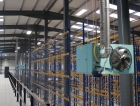Efficient space heating for vehicle climate-control specialist

Powrmatic heating equipment for the new warehouse and test facility at Ringwood of Eberspacher UK comprises seven NVS condensing warm-air heaters and 11 CECx destratification fans. The equipment was specified and installed by PWB Industrial Heating Services.
The facility has a BREEAM ‘Good’ rating and replaces three separate facilities to bring all the company’s UK operations under one roof. The company is a major supplied to climate-control systems to man manufacturers for cars and commercial vehicles.
Paul Jarvis of Eberspacher explains, ‘Energy-efficient performance for the new building was a key criterion for minimising our carbon footprint, gaining BREEAM certification and reducing running costs. The specification was therefore for warm-air heaters, combined with a destratification system.
The heaters have been installed in the warehouse and vehicle test facility.
The warehouse is very high, with racking up to 8 m in some areas. Heaters are controlled individually via links to strategically located temperature sensors.
The vehicle test area is used for testing climate-control systems in a variety of environments, including hot climates. For this reason, the system to create room temperatures of up to 45°C, which is achieved by a 90 kW NVS unit and two destratification fans.








